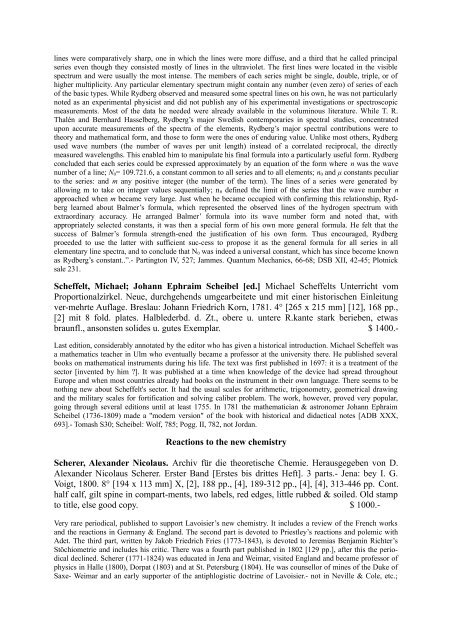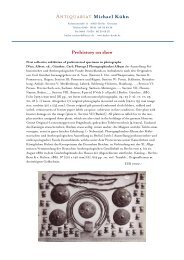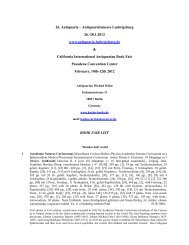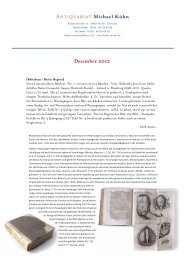List New York Antiquarian Book Fair - Antiquariat - Michael Kühn
List New York Antiquarian Book Fair - Antiquariat - Michael Kühn
List New York Antiquarian Book Fair - Antiquariat - Michael Kühn
You also want an ePaper? Increase the reach of your titles
YUMPU automatically turns print PDFs into web optimized ePapers that Google loves.
lines were comparatively sharp, one in which the lines were more diffuse, and a third that he called principal<br />
series even though they consisted mostly of lines in the ultraviolet. The first lines were located in the visible<br />
spectrum and were usually the most intense. The members of each series might be single, double, triple, or of<br />
higher multiplicity. Any particular elementary spectrum might contain any number (even zero) of series of each<br />
of the basic types. While Rydberg observed and measured some spectral lines on his own, he was not particularly<br />
noted as an experimental physicist and did not publish any of his experimental investigations or spectroscopic<br />
measurements. Most of the data he needed were already available in the voluminous literature. While T. R.<br />
Thalén and Bernhard Hasselberg, Rydberg’s major Swedish contemporaries in spectral studies, concentrated<br />
upon accurate measurements of the spectra of the elements, Rydberg’s major spectral contributions were to<br />
theory and mathematical form, and those to form were the ones of enduring value. Unlike most others, Rydberg<br />
used wave numbers (the number of waves per unit length) instead of a correlated reciprocal, the directly<br />
measured wavelengths. This enabled him to manipulate his final formula into a particularly useful form. Rydberg<br />
concluded that each series could be expressed approximately by an equation of the form where n was the wave<br />
number of a line; N0= 109.721.6, a constant common to all series and to all elements; n0 and μ constants peculiar<br />
to the series: and m any positive integer (the number of the term). The lines of a series were generated by<br />
allowing m to take on integer values sequentially; n0 defined the limit of the series that the wave number n<br />
approached when m became very large. Just when he became occupied with confirming this relationship, Rydberg<br />
learned about Balmer’s formula, which represented the observed lines of the hydrogen spectrum with<br />
extraordinary accuracy. He arranged Balmer’ formula into its wave number form and noted that, with<br />
appropriately selected constants, it was then a special form of his own more general formula. He felt that the<br />
success of Balmer’s formula strength-ened the justification of his own form. Thus encouraged, Rydberg<br />
proeeded to use the latter with sufficient suc-cess to propose it as the general formula for all series in all<br />
elementary line spectra, and to conclude that N0 was indeed a universal constant, which has since become known<br />
as Rydberg’s constant..”.- Partington IV, 527; Jammes. Quantum Mechanics, 66-68; DSB XII, 42-45; Plotnick<br />
sale 231.<br />
Scheffelt, <strong>Michael</strong>; Johann Ephraim Scheibel [ed.] <strong>Michael</strong> Scheffelts Unterricht vom<br />
Proportionalzirkel. Neue, durchgehends umgearbeitete und mit einer historischen Einleitung<br />
ver-mehrte Auflage. Breslau: Johann Friedrich Korn, 1781. 4° [265 x 215 mm] [12], 168 pp.,<br />
[2] mit 8 fold. plates. Halblederbd. d. Zt., obere u. untere R.kante stark berieben, etwas<br />
braunfl., ansonsten solides u. gutes Exemplar. $ 1400.-<br />
Last edition, considerably annotated by the editor who has given a historical introduction. <strong>Michael</strong> Scheffelt was<br />
a mathematics teacher in Ulm who eventually became a professor at the university there. He published several<br />
books on mathematical instruments during his life. The text was first published in 1697: it is a treatment of the<br />
sector [invented by him ?]. It was published at a time when knowledge of the device had spread throughout<br />
Europe and when most countries already had books on the instrument in their own language. There seems to be<br />
nothing new about Scheffelt's sector. It had the usual scales for arithmetic, trigonometry, geometrical drawing<br />
and the military scales for fortification and solving caliber problem. The work, however, proved very popular,<br />
going through several editions until at least 1755. In 1781 the mathematician & astronomer Johann Ephraim<br />
Scheibel (1736-1809) made a "modern version" of the book with historical and didactical notes [ADB XXX,<br />
693].- Tomash S30; Scheibel: Wolf, 785; Pogg. II, 782, not Jordan.<br />
Reactions to the new chemistry<br />
Scherer, Alexander Nicolaus. Archiv für die theoretische Chemie. Herausgegeben von D.<br />
Alexander Nicolaus Scherer. Erster Band [Erstes bis drittes Heft]. 3 parts.- Jena: bey I. G.<br />
Voigt, 1800. 8° [194 x 113 mm] X, [2], 188 pp., [4], 189-312 pp., [4], [4], 313-446 pp. Cont.<br />
half calf, gilt spine in compart-ments, two labels, red edges, little rubbed & soiled. Old stamp<br />
to title, else good copy. $ 1000.-<br />
Very rare periodical, published to support Lavoisier’s new chemistry. It includes a review of the French works<br />
and the reactions in Germany & England. The second part is devoted to Priestley’s reactions and polemic with<br />
Adet. The third part, written by Jakob Friedrich Fries (1773-1843), is devoted to Jeremias Benjamin Richter’s<br />
Stöchiometrie and includes his critic. There was a fourth part published in 1802 [129 pp.], after this the periodical<br />
declined. Scherer (1771-1824) was educated in Jena and Weimar, visited England and became professor of<br />
physics in Halle (1800), Dorpat (1803) and at St. Petersburg (1804). He was counsellor of mines of the Duke of<br />
Saxe- Weimar and an early supporter of the antiphlogistic doctrine of Lavoisier.- not in Neville & Cole, etc.;








